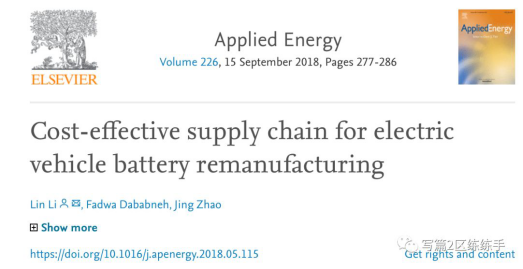1文章导读
最近,由于能源消耗和气候变化,能源和环境可持续性问题引起了越来越多的关注。特别是对于运输部门,全球约有9亿辆汽车在使用,其能源使用的96%来自化石资源。幸运的是,电动汽车(EV)具有多种与能源和环境相关的优势,并且显示出是传统汽油车辆的坚定替代品。
2期刊信息
Applied Energy
226(2018),Pages 277-286
Received 23 March 2018
Revised 11 May 2018
Accepted 27 May 2018
3摘要
大规模采用电动汽车可以获得显着的能源和环境效益,同时还可以减少对化石燃料的依赖。尽管如此,伴随着电动车辆的益处,锂离子电池的生产也产生了一些经济和生态挑战,锂离子电池是目前电动车辆中最常用的电池类型。再制造是一种很有前途的报废战略,可以带来更可持续的锂离子电池供应链,以支持大规模采用电动汽车。有几个因素决定了再制造的可行性和有效性,包括经济可行性,生产能力以及电池供需。不幸的是,虽然在实验室规模上对再制造进行了大量研究,但缺乏研究企业规模的锂离子电池再制造的研究。受此启发,本文提出了一种针对不同质量水平的废旧电池回收的锂离子电池再制造的最先进的闭环供应链网络模型。开发优化模型以最大化网络利润,并且执行灵敏度分析以确定若干重要模型参数对所提议的供应链网络的盈利能力的影响。实施了一个数值案例研究,表明如果再制造集成在锂离子电池供应链网络中,可以实现9.81-30.93%的利润增长。此外,灵敏度分析表明,仔细实施所提出的算法,加上对电池参数的理解,是实现具有成本效益的电动汽车锂离子电池供应链的关键。总之,这项研究将有助于促进再制造的实施,促进电动汽车电池行业的经济和环境可持续供应链管理,并支持运输部门减少环境负担。
关键词:电动汽车;锂离子电池;再制造;闭环供应链
4原文信息

Abstract
Large-scale adoption of electric vehicles can reap significant energy and environmental benefits while also reducing reliance on fossil fuels.Nonetheless,accompanying the benefits of electric vehicles,several economic and ecological challenges arise from the production of Lithium-ion batteries,which are currently the most popular type of batteries used in electric vehicles.Remanufacturing is a promising end-of-life strategy and can lead to more sustainable Lithium-ion battery supply chains to support large-scale adoption of electric vehicles.Several factors will dictate the feasibility and effectiveness of remanufacturing,including economic viability,production capability,and battery demand and supply.Unfortunately,while there exists significant research efforts on remanufacturing at the laboratory scale,there lacks research that investigates Lithium-ion battery remanufacturing at the enterprise scale.Motivated by this,in this paper,a state-of-the-art closed loop supply chain network model for Lithium-ion battery remanufacturing considering different quality levels of spent battery returns is proposed.An optimization model is developed to maximize the network profit and a sensitivity analysis is performed to determine the impact of several important model parameters on the profitability of the proposed supply chain network.A numerical case study is implemented which shows that 9.81–30.93%increase in profit can be achieved if remanufacturing is integrated in Lithium-ion battery supply chain networks.Moreover,the sensitivity analysis shows that careful implementation of the proposed algorithm coupled with understanding of battery parameters are the keys to implementing cost-effective electric vehicle Lithium-ion battery supply chains.In all,this research will help stimulate the implementation of remanufacturing,promote economically and environmentally sustainable supply chain management in the electric vehicle battery industry,and support the transportation sector in reducing environmental burdens.
Keywords
Electric vehicle;Lithium-ion battery;Remanufacturing;Closed loop supply chain
5重要概念
1、闭环供应链(CLSC)网络模型:闭环供应链是指企业从采购到最终销售的完整供应链循环,包括了产品回收与生命周期支持的逆向物流。它的目的是对物料的流动进行封闭处理,减少污染排放和剩余废物,同时以较低的成本为顾客提供服务。使用闭环供应链(CLSC)电池网络模型,以降低网络的总成本,并从废弃电池中回收可回收材料。
2、敏感性分析(Sensitivity analysis):从多个不确定性因素中逐一找出对投资项目经济效益指标有重要影响的敏感性因素,并分析、测算其对项目经济效益指标的影响程度和敏感性程度,进而判断项目承受风险的能力。进行敏感性分析以研究所提出的CLSC网络模型在整合再制造基础设施的同时改变几个重要参数的盈利能力。
6句式参考
1、While promising,the aforementioned results are based on......虽然很有希望,但上述结果是基于模拟案例中假设的模型设置和参数值。
2、The proposed model will help remanufacturing stakeholders better understand the macro-level economics associated with electric vehicle Lithium-ion battery remanufacturing,and will provide planning and decision-making methodology for remanufacturing stakeholders at the enterprise level.
该模型将帮助再制造利益相关者更好地理解与电动汽车锂离子电池再制造相关的宏观经济学,并将为企业级再制造利益相关者提供规划和决策方法。
3、A major consideration that arises when studying the economics of LIB recycling and remanufacturing is the relatively low cost and profuse availability of the raw materials(such as Lithium and Cobalt)needed to produce LIBs.在研究LIB回收和再制造的经济性时出现的一个主要考虑因素是生产LIB所需的原材料(如锂和钴)的成本相对较低且可获得的大量可用性。
文章作者:
Lin Li⁎,Fadwa Dababneh,Jing Zhao

